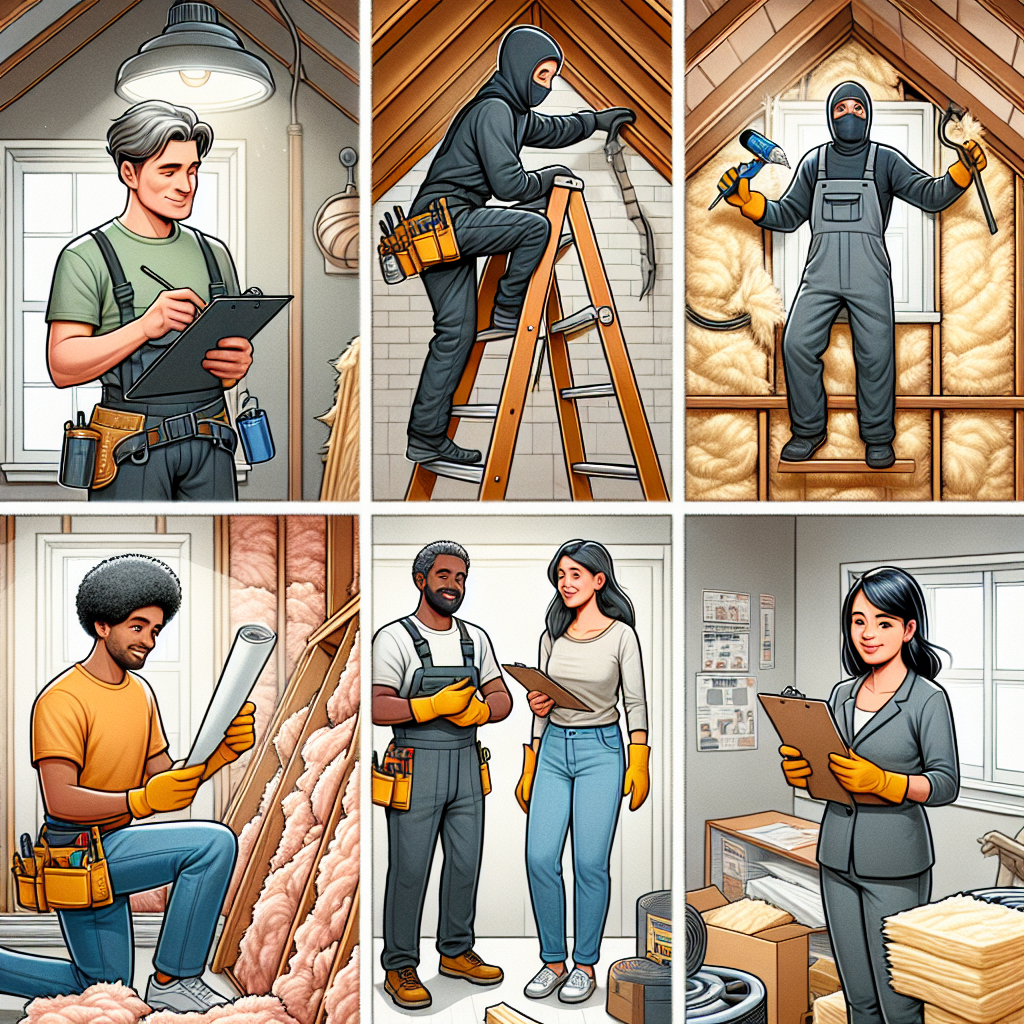Maintaining and Updating Home Insulation
-
Table of Contents
Maintaining and updating home insulation is crucial for ensuring energy efficiency, comfort, and cost savings in any household. Proper insulation acts as a barrier to heat flow, keeping your home warm in the winter and cool in the summer. Over time, insulation can degrade, become less effective, or suffer damage from pests, moisture, or other environmental factors. Regular maintenance and timely updates can prevent these issues, enhance the performance of your insulation, and reduce energy bills. By addressing insulation needs, homeowners can also contribute to a more sustainable environment by lowering their overall energy consumption.
Benefits Of Regularly Updating Home Insulation
Maintaining and updating home insulation is a crucial aspect of homeownership that often goes overlooked. However, the benefits of regularly updating home insulation are manifold, extending beyond mere comfort to encompass significant financial and environmental advantages. To begin with, one of the most immediate benefits of updating home insulation is the enhancement of energy efficiency. Proper insulation acts as a barrier, preventing the escape of warm air during the winter and cool air during the summer. This means that heating and cooling systems do not have to work as hard to maintain a comfortable indoor temperature, leading to a reduction in energy consumption. Consequently, homeowners can expect a noticeable decrease in their utility bills, which can be particularly significant over time.
In addition to energy savings, regularly updating home insulation contributes to a more consistent indoor climate. Older or deteriorating insulation can lead to drafts and uneven temperatures throughout the home, making certain areas uncomfortable. By ensuring that insulation is up-to-date and in good condition, homeowners can enjoy a more stable and comfortable living environment. This is especially important for households with young children, elderly members, or individuals with health conditions that make them more sensitive to temperature fluctuations.
Moreover, updating home insulation can have a positive impact on the environment. Reduced energy consumption translates to a lower carbon footprint, as less energy is required to heat and cool the home. This is particularly relevant in the context of global efforts to combat climate change. By taking steps to improve the energy efficiency of their homes, individuals can contribute to broader environmental sustainability goals. Furthermore, modern insulation materials are often more environmentally friendly than their older counterparts, incorporating recycled content and being designed for better performance and longevity.
Another significant benefit of regularly updating home insulation is the potential increase in property value. Energy efficiency is an increasingly important factor for homebuyers, and a well-insulated home can be a strong selling point. Prospective buyers are often willing to pay a premium for homes that promise lower energy bills and a more comfortable living environment. Therefore, investing in updated insulation can yield a substantial return when it comes time to sell the property.
Additionally, proper insulation can enhance the overall durability and longevity of a home. Insulation helps to protect the structure from moisture, which can lead to issues such as mold growth, wood rot, and structural damage. By keeping moisture at bay, homeowners can avoid costly repairs and maintain the integrity of their property. This is particularly important in regions with high humidity or significant temperature variations, where the risk of moisture-related problems is greater.
Furthermore, updating home insulation can improve indoor air quality. Older insulation materials can deteriorate over time, releasing particles and fibers into the air. Modern insulation options are designed to be more stable and less likely to degrade, thereby contributing to a healthier indoor environment. This is especially beneficial for individuals with allergies or respiratory conditions, who may be more sensitive to airborne contaminants.
In conclusion, the benefits of regularly updating home insulation are extensive and multifaceted. From enhanced energy efficiency and cost savings to improved comfort, environmental sustainability, increased property value, and better indoor air quality, the advantages are clear. Homeowners who prioritize the maintenance and updating of their insulation are making a wise investment in their property and their quality of life. As such, it is essential to recognize the importance of this often-overlooked aspect of home maintenance and take proactive steps to ensure that insulation remains effective and up-to-date.
How To Identify And Fix Common Insulation Problems

Maintaining and updating home insulation is crucial for ensuring energy efficiency, comfort, and cost savings. Identifying and fixing common insulation problems can significantly enhance the performance of your home’s thermal envelope. To begin with, it is essential to recognize the signs of inadequate insulation. One of the most apparent indicators is fluctuating indoor temperatures, which often result in increased heating and cooling costs. Additionally, drafts, cold spots, and uneven temperatures between rooms can signal insulation issues. High energy bills, despite moderate usage, also suggest that your insulation may not be performing optimally.
To accurately diagnose insulation problems, a thorough inspection is necessary. Start by examining the attic, as it is a primary area where heat loss occurs. Look for gaps, compressed or damaged insulation, and signs of moisture, such as mold or mildew. Moisture can compromise the effectiveness of insulation materials, leading to reduced thermal resistance. Furthermore, inspect the walls by using an infrared thermometer or thermal imaging camera to detect cold spots, which indicate areas lacking proper insulation. Pay attention to the basement and crawl spaces, as these areas are prone to air leaks and insufficient insulation.
Once you have identified the problem areas, the next step is to address them effectively. For minor gaps and cracks, applying caulk or weatherstripping can significantly reduce air leakage. In the attic, adding or replacing insulation is often necessary. Fiberglass batts, blown-in cellulose, and spray foam are common materials used for attic insulation. Each has its advantages; for instance, spray foam provides excellent air sealing properties, while blown-in cellulose is effective for filling irregular spaces. When adding insulation, ensure it is evenly distributed and not compressed, as this can diminish its insulating properties.
Wall insulation can be more challenging to update, especially in existing homes. One method is to inject foam insulation into wall cavities through small holes drilled into the drywall. This technique minimizes disruption while enhancing thermal performance. Alternatively, if you are undertaking a renovation, consider installing rigid foam boards or adding a layer of insulation to the exterior walls before applying new siding. This approach not only improves insulation but also enhances the overall building envelope.
Basements and crawl spaces require special attention due to their susceptibility to moisture and air infiltration. Insulating basement walls with rigid foam boards or spray foam can create a moisture barrier and improve thermal resistance. For crawl spaces, installing a vapor barrier on the ground and insulating the walls can prevent moisture buildup and reduce heat loss. Additionally, sealing ductwork and insulating pipes in these areas can further enhance energy efficiency.
Regular maintenance is essential to ensure the longevity and effectiveness of your insulation. Periodically inspect your home for signs of wear and tear, such as sagging or discolored insulation, which may indicate water damage or pest infestation. Address any issues promptly to prevent further deterioration. Moreover, consider scheduling a professional energy audit every few years. Energy auditors use specialized equipment to assess your home’s insulation and identify areas for improvement, providing valuable insights and recommendations.
In conclusion, maintaining and updating home insulation involves identifying common problems, conducting thorough inspections, and implementing appropriate solutions. By addressing insulation issues promptly and effectively, homeowners can achieve significant energy savings, enhanced comfort, and a more sustainable living environment. Regular maintenance and professional assessments further ensure that your insulation continues to perform optimally, safeguarding your investment and contributing to a more energy-efficient home.
Cost-Effective Ways To Upgrade Your Home’s Insulation
Upgrading your home’s insulation is a cost-effective way to enhance energy efficiency, reduce utility bills, and improve overall comfort. As energy costs continue to rise, homeowners are increasingly seeking methods to optimize their insulation without incurring exorbitant expenses. Fortunately, there are several strategies to achieve this goal, each offering a balance between affordability and effectiveness.
One of the most straightforward and economical approaches to upgrading insulation is to focus on areas that are often overlooked yet significantly impact energy loss. For instance, attic insulation plays a crucial role in maintaining a stable indoor temperature. By adding or replacing insulation in the attic, homeowners can prevent heat from escaping during the winter and entering during the summer. Materials such as fiberglass batts, cellulose, and spray foam are commonly used for this purpose, each offering varying degrees of thermal resistance and cost.
In addition to the attic, walls are another critical area where insulation can be improved. While retrofitting wall insulation can be more challenging and costly than attic insulation, it is still a viable option for older homes with inadequate or deteriorated insulation. Blown-in cellulose or injection foam can be installed into wall cavities without the need for extensive demolition, making it a less invasive and more affordable solution.
Another cost-effective method to enhance insulation is to seal air leaks around windows, doors, and other openings. Air infiltration can significantly undermine the effectiveness of existing insulation, leading to higher energy consumption and discomfort. Weatherstripping, caulking, and expanding foam are practical tools for sealing gaps and cracks, thereby improving the overall thermal envelope of the home. These materials are relatively inexpensive and can be applied by homeowners with basic DIY skills.
Furthermore, upgrading insulation in the basement or crawl space can yield substantial energy savings. These areas are often neglected, yet they can be significant sources of heat loss. Installing rigid foam boards or spray foam insulation along the walls and floors of basements and crawl spaces can create a more consistent indoor environment and reduce the strain on heating and cooling systems.
In addition to these specific areas, it is essential to consider the type of insulation material used. While traditional materials like fiberglass and cellulose are cost-effective and widely available, newer options such as spray foam and rigid foam boards offer superior thermal performance and longevity. Although these advanced materials may have a higher initial cost, their long-term benefits in terms of energy savings and durability can make them a worthwhile investment.
Moreover, homeowners should not overlook the importance of proper installation. Even the best insulation materials can underperform if not installed correctly. Hiring a professional contractor with experience in insulation can ensure that the job is done right, maximizing the effectiveness of the upgrade and preventing potential issues such as moisture buildup and mold growth.
In conclusion, upgrading home insulation does not have to be a prohibitively expensive endeavor. By focusing on key areas such as the attic, walls, and basement, sealing air leaks, and choosing the right materials, homeowners can achieve significant improvements in energy efficiency and comfort. Additionally, proper installation is crucial to realizing the full benefits of any insulation upgrade. With careful planning and execution, these cost-effective strategies can lead to substantial long-term savings and a more comfortable living environment.
Read more about Home Insulation
- Benefits of Home Insulation
- Types of Home Insulation
- Choosing the Right Insulation for Your Home
- Common DIY Home Insulation Mistakes
- Insulation for Different Areas of Your Home
- Signs of Poor Home Insulation
- Home Insulation ROI (Return on Investment)
- How to Improve Home Insulation without Breaking the Bank
- Upgrading Home Insulation for Extreme Climates
- Maintaining and Updating Home Insulation








